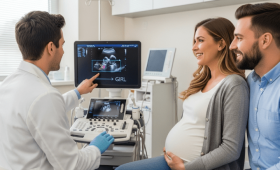What Is Gender Selection?
Gender selection is a medical procedure used by a couple to determine the gender of their future child. This process is not possible with natural pregnancies. Gender selection can only be performed during in vitro fertilization (IVF) treatment by genetically examining the fertilized embryos.
During this process, the gender chromosomes (X and Y) of the embryos are identified, and the embryo of the desired gender is transferred to the expectant mother’s uterus. This method is of vital importance, especially for preventing the transmission of gender-linked hereditary diseases.
Is Gender Determination Legal?
The gender determination process is subject to different legal regulations in each country. In Turkey and many European countries, this procedure can only be legally performed in cases of medical necessity, such as to prevent the transmission of a gender-linked genetic disease.
Gender selection for family balancing or personal preference is generally not legal. However, in some countries, such as the United States, Mexico, and Northern Cyprus, this procedure is legally permitted. Therefore, it is very important to research the laws of the relevant country in detail before starting the treatment.
In Which Cases Is Gender Selection Performed?
Gender selection is usually performed when there are gender-linked genetic diseases in the family. For example, gender selection can be performed to prevent the transmission of diseases that only affect male children, such as hemophilia or muscular dystrophy, to the next generation. This is a method used to increase the chance of couples having a healthy child. In some countries, it can also be applied based on personal preferences to ensure the gender balance of the family’s existing children.
Gender Selection and IVF
Gender selection is a process only possible with in vitro fertilization treatment. This procedure is performed during the stage when embryos are formed and examined in a laboratory environment. Before the embryos are transferred to the mother’s womb, their genders are determined using genetic tests.
This is a fundamental part of the treatment and also allows for the genetic health of the embryos to be checked. Gender selection can be applied within certain rules, both medically and legally, thanks to this special method.
How Does the PGT Method Work?
Preimplantation Genetic Testing (PGT) is an advanced genetic analysis method used in IVF treatment. During this process, a small cell sample is taken from the embryo at an early stage of its development. This cell sample is then examined in detail in a genetic laboratory. This examination allows for the determination of the embryo’s gender chromosomes (X and Y) as well as whether it carries any potential genetic diseases. After the results are obtained, the healthiest embryo of the desired gender is selected for transfer into the uterus. This process significantly increases the success rate of the treatment.
Is There a Gender Selection Surgery?
No, gender selection is not a surgery. This procedure is a microscopic process performed in a laboratory environment instead of a surgical operation. Fertilization and embryo development are completed in the laboratory, and a cell sample taken from the embryo is genetically analyzed. This process does not require any surgical intervention. The embryo transfer is also a simple, non-surgical procedure and is usually completed painlessly.

What Is the Gender Selection Success Rate?
The success rate of the gender selection process is close to 100% thanks to Preimplantation Genetic Testing (PGT). The PGT method can determine the gender chromosomes of the embryo with extremely high accuracy. However, the overall success rate of IVF treatment varies depending on many factors such as the expectant mother’s age, egg quality, and general health condition. Therefore, even if gender selection is technically successful, the realization of the pregnancy depends on these general factors.
How Long Does the Treatment Process Take?
The IVF treatment process, which includes gender selection, generally takes between 2 to 4 weeks. The process begins with the stimulation of the ovaries with hormonal drugs, and this stage takes about 10-14 days. After the egg retrieval procedure, the embryos are expected to develop in the laboratory environment. The PGT test and the results also add to this process. Finally, the embryo transfer is performed at the most opportune time. All these stages determine the total duration of the treatment.
Gender Selection Abroad
Gender selection is a popular treatment option abroad for couples for whom it is not legal in their home country. Generally, countries such as the United States, Northern Cyprus, and Mexico are preferred. These countries legally permit gender selection for family balancing purposes. Treatment abroad can also offer advantages such as high success rates, advanced technological facilities, and privacy. You can get support from international health tourism consultancy firms like Cure Holiday to get detailed information and plan your trip.
What Are the Treatment Costs?
Gender selection treatment is generally more costly than standard IVF treatment. The most important reason for this is the additional cost of the PGT (Preimplantation Genetic Testing) procedure. The total cost varies greatly depending on the chosen country, clinic, medications used, and any additional tests that may be required. It is important for couples to clearly understand all the costs and plan their budget accordingly before starting the treatment.
What Are the Tips for a Baby Boy?
In society, there is a widespread belief that there are some nutritional and timing tips for having a baby boy. According to these beliefs, consuming foods rich in potassium and sodium (bananas, red meat, potatoes) and having intercourse on the day of ovulation increases the chance of a baby boy. However, these beliefs have no scientific basis. The baby’s gender is determined by a sperm carrying a Y chromosome fertilizing the egg, and this is a completely genetic event. Focusing on a balanced diet for a healthy pregnancy is the right thing to do.
What Should Be Done for a Baby Girl?
Similar beliefs exist for those who want to have a baby girl. According to these beliefs, consuming foods rich in calcium and magnesium (milk, yogurt, leafy green vegetables) and having intercourse a few days before ovulation increases the chance of a baby girl. These theories also have no scientific validity. The pH balance of the body cannot be changed with diet. The most important thing is to take care of yourself and your nutrition for a healthy pregnancy.
Which Country Is Best for Gender Selection?
The best country for gender selection varies according to the needs and legal expectations of the couples. Countries such as the United States, Northern Cyprus, Mexico, and Thailand are popular because they offer legal flexibility and have experienced centers in this field. Before treatment, you should carefully research the legal regulations, costs, success rates, and patient services in the country you choose.
What Is the Importance of Age in Gender Selection?
Although gender selection itself is not dependent on age, age has a great impact on the overall success rate of IVF treatment. As women get older, the quality and number of eggs decrease. This situation lowers the chance of obtaining a healthy embryo and getting pregnant. Therefore, even for gender selection, considering treatment as early as possible can help increase the chance of success.
Is Gender Selection with Natural Methods Possible?
No, gender selection with natural methods is not scientifically possible. Popular methods such as the Chinese calendar, Mayan calendar, diet, and timing of intercourse have no scientific basis. The success rate of these methods does not go beyond a random chance of 50%. Such methods are generally for entertainment purposes and do not give a definitive result.
Gender Selection and Religious Beliefs
Gender selection is a topic that is open to different interpretations from a religious point of view. While some belief systems do not accept such interventions, others may allow it under certain conditions. This is a completely personal decision, and it is important for couples to reach a decision by taking their own religious and ethical values into consideration. It is important to evaluate this issue in line with your own beliefs before starting the treatment.
Preparations Before IVF Treatment
Before IVF treatment, it is of great importance to prepare both physically and psychologically. Couples should adopt a healthy lifestyle, exercise regularly, and stay away from harmful habits such as smoking and alcohol. In addition, staying away from stress and getting plenty of rest can also positively affect the success of the treatment. In this process, partner support is one of the most important sources of motivation.
Is Embryo Genetics Checked?
Yes, the PGT method used for gender selection examines the genetic structure of the embryos in detail. This examination not only determines the gender but also can detect whether the embryo has chromosomal abnormalities like Down syndrome or single-gene diseases. In this way, only healthy embryos are transferred to the uterus, which increases the chance of pregnancy and reduces the risk of miscarriage.
Psychological Support in Treatment
The IVF treatment process can be very challenging for couples, both physically and emotionally. The uncertainty of the treatment, the financial burden, and hormonal changes can increase psychological stress. Therefore, it is very important to get psychological support or for couples to support each other during the treatment process. This support will help you get through the process more easily and strengthen your relationship. You can also consider the relaxing vacation opportunities offered by Cure Holiday to reduce stress.
Common Misconceptions in Gender Selection
There are many misconceptions about gender selection. The most common ones are that the severity of morning sickness during pregnancy, the type of craving, or the shape of the belly determines the baby’s gender. These beliefs have no scientific basis. Morning sickness and cravings are related to hormonal changes and can be experienced differently by every pregnant woman. Such beliefs are for entertainment purposes only and are far from scientific facts.
Are There Risks of the PGT Method?
The PGT method is generally considered a safe procedure. Taking a cell sample from the embryo is a process that could potentially harm the embryo, but in modern laboratories, this risk is very low. In addition, since genetically unhealthy embryos are eliminated with this test, the chance of pregnancy success increases and the risk of miscarriage decreases. Therefore, the potential risks of PGT should be evaluated along with the benefits it offers.
Why Is Treatment Abroad Preferred?
The most important reasons for preferring treatment abroad include access to procedures like gender selection that may not be legal in one’s home country, more affordable costs, shorter waiting times, and centers with advanced technology. In addition, getting away from the stress of daily life during the treatment can help couples focus better on the process. International health tourism consultants can facilitate the entire process for such treatments.
Do Egg and Sperm Quality Affect Gender?
Egg and sperm quality are vital for pregnancy to occur, but they do not determine the baby’s gender. Gender is determined at the moment of fertilization by the chromosome carried by the sperm that fertilizes the egg. A sperm carrying a Y chromosome moves faster, while a sperm carrying an X chromosome is more durable. However, this is a coincidence rather than a certainty, and sperm or egg quality does not change this coincidence.
Is Gender Known During the Treatment Process?
Yes, during gender selection treatment, the baby’s gender is known before the embryo transfer is performed. The PGT test results clearly show the embryo’s gender. This allows couples to make an informed decision and ensures that the embryo of the desired gender is transferred.
Can Gender Selection Be Done Again?
If more than one healthy embryo is obtained in the first treatment cycle and these embryos are frozen, it is possible to do gender selection again at a later date. Frozen embryos can be thawed and used in a new pregnancy attempt. This provides an opportunity to try again without the need for invasive procedures like egg retrieval each time.
What Are the Factors That Increase the Success of IVF Treatment?
Factors that increase the success of IVF treatment include the age of the couple, egg and sperm quality, a healthy diet and lifestyle, staying away from stress, and applying the correct treatment protocol. Additional technologies like genetic screening (PGT) also significantly increase the success rate as they guarantee the transfer of a healthy embryo.
Gender Selection and the Risk of Multiple Pregnancy
The risk of multiple pregnancy in IVF treatment is related to the number of embryos transferred. Since multiple pregnancies can bring risks such as premature birth and low birth weight, a single embryo transfer is generally preferred in gender selection cases. This is the safest approach for the health of both the mother and the baby.
What Are the Medical Gender Determination Methods?
There are several definitive methods for medically determining a baby’s gender. The most common among these is the ultrasound examination performed between the 16th and 20th weeks of pregnancy. In addition, genetic tests such as Non-invasive Prenatal Test (NIPT), chorionic villus sampling (CVS), and amniocentesis can determine the baby’s gender with almost 100% accuracy.

How to Start Treatment Abroad?
To start treatment abroad, you should first research the legal regulations and treatment costs of the relevant countries. Then, you can contact an organization that offers international patient consultancy services like Cure Holiday. These consultants will help you determine the most suitable clinic and treatment plan for you and arrange all the logistical details such as travel and accommodation.
Is Gender Selection Ethically Controversial?
Yes, especially gender selection performed without a medical necessity is an ethically controversial topic. These debates are based on concerns such as babies being seen as consumer goods, a gender imbalance in society, and causing inequality between genders. For this reason, many countries have imposed legal restrictions on this procedure.
Partner Support During the IVF Process
The IVF process is a shared journey for couples, and partner support is vital during this period. It is very important for the partner to be emotionally supportive, attend all appointments, and be knowledgeable about the process to reduce stress and increase motivation. Couples who support each other can get through this difficult process more easily and strengthen their relationship.
Who Is Gender Selection Treatment Suitable For?
Gender selection treatment is valid for couples who are suitable for IVF treatment. Before starting the treatment, couples should undergo a detailed health check and factors such as sperm and egg quality should be evaluated. In addition, if you are considering this treatment, it is important to thoroughly research the laws and ethical regulations in your home country.
Technologies Used in Treatment
Advanced technologies are used in gender selection treatment. The most important of these is the PGT (Preimplantation Genetic Testing) method, which examines the genetic structure of the embryos. In addition, methods such as ICSI (Intracytoplasmic Sperm Injection), in which sperm is injected into the egg, are also used to increase the success of the treatment.
How Is Embryo Transfer Performed?
Embryo transfer is one of the final and simplest stages of IVF treatment. During this procedure, the selected healthy embryo is placed in the expectant mother’s uterus with the help of a thin and flexible catheter under ultrasound guidance. It is generally a painless and fast procedure. Short-term rest is recommended after the transfer, but long-term bed rest is generally not necessary.
How Certain Are the Results?
The PGT method used for gender selection offers extremely high accuracy thanks to genetic analysis. The gender information obtained from this method is almost 100% certain. Therefore, the possibility of being surprised with gender selection done with PGT is very low.
Do Eating Habits Affect Gender?
Although eating habits are extremely important for the health of the mother and baby, they do not determine the baby’s gender. Although some diets are recommended to change the body’s pH balance, these beliefs have no scientific basis. Gender is only dependent on the chromosome carried by the sperm from the father. Therefore, instead of trying to influence gender selection, it is best to focus on a healthy and balanced diet.



